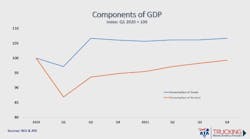For the week ending Oct. 4, supply chain interruptions pushed freight to the spot market, raising overall available loads by 5% and allowing the spot van rate national average to reach a record high of $2.46/mile, according to DAT Freight & Analytics.
DAT pointed to available capacity dipping 1.5% as a reason van, refrigerated, and flatbed load-to-truck ratios were higher. This builds on September, which DAT called “unseasonably strong” for national average rates. Spot load posts more than doubled to 116% and truck posts decreased 6.2% year over year (YOY).
Versus last September, each segment experienced a sizable boost:
- Van: $2.38 per mile (up 28.9% YOY);
- Flatbed: $2.41 per mile (up 9.8% YOY);
- Reefer: $2.57 per mile (19.1% YOY)
Here’s a chart of the growth from the start of Q3 2020 through the first week of October.
Drilling down, the national average van spot rates were $0.08 higher than the September average. Los Angeles was up $0.07 from the previous week, hitting $3.37, due to record cargo volumes at ports of Los Angeles and Long Beach. The August total container volume were at record highs at the L.A. port—over 960,000 TEU (20-ft. equivalent units), doubling March levels. On the eastern side of the country, business around the Lehigh Valley was booming, with van rates shooting up $0.19 to $2.92/mile around Allentown, Pa.
Flatbed available loads on the top 78 lanes increased 2.2%, with rates from Cleveland, Ohio, up $0.10 over the previous two weeks, now at $2.70. Outbound load volumes from the Pacific Northwest rose 17% week over week, with nearly one in five loads heading down the coast to Southern California.
Reefer rates are higher than usual, about 20% more than September 2019, though 48 of the 72 top reefer lanes were lower or stagnant, indicating signs of a plateau.
Overall economy
This adds to other positive signs that the economy is improving. Due to the COVID-19 pandemic, real GDP plummeted 31.7% in Q2 2020, though the American Trucking Associations’ (ATA) chief economist, Bob Costello, predicted Q3 would increase 30%, prompting him to say, “The recession is likely over.”
Costello projected GDP to be up 2.5% for Q4 and build on that in Q1f 2021 with a 3.3% increase.
Freight has been somewhat insulated from the overall recession because goods declined only 5% while services (because of safe distancing and nationwide shutdowns) dropped 15%. Goods consumption looks to be steady until at least the end of 2021, according to the ATA.
About the Author
FleetOwner Staff
Our Editorial Team
Kevin Jones, Editorial Director, Commercial Vehicle Group
Josh Fisher, Editor-in-Chief
Jade Brasher, Senior Editor
Jeremy Wolfe, Editor
Jenna Hume, Digital Editor
Eric Van Egeren, Art Director


